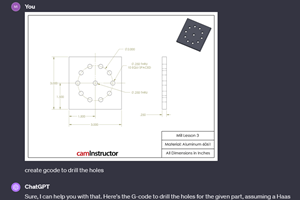Getting The Job Done
This computer-aided manufacturing software package that generates simultaneous two- through five-axis NC tool paths and provides parametric 3D modeling. All geometric modeling and tool path functions are fully associative.
Share






N.M.F. Canada is strategically located in the heart of the Canadian aerospace community in Mirabel, Quebec, near some of the world’s largest aerospace companies, including Bombardier Aerospace, Pratt & Whitney, Bell Helicopter and many others. N.M.F. Canada fabricates the aluminum skin that covers the structural skeleton of airplane wings. “Our determination to ‘get the job done’ is simple; once price is established, ‘quality and on-time delivery’ is non-negotiable,” says David F. Cook, President of N.M.F. Canada.
Building of the modern, 100,000 plus sq. foot wing skin manufacturing facility began in 1992 at the request of Bombardier. Phase III included the addition of 45,000 sq. feet and the installation of a 10,000 rpm, three spindle, five-axis Cincinnati Gantry milling machine. The five-axis gantry is capable of machining components up to 60 feet long and within very precise tolerances.
“We needed a system that we knew could ‘get the job done’ and that had a proven history of successful five-axis installations,” says Michael Deshaies. “Our goal was to have programs ready to go when the machine hit the floor.”
The team selected NCL multi-axis machining software from NCCS (Newport Beach, California). NCL is a computer-aided manufacturing software package that generates simultaneous two- through five-axis NC tool paths and provides parametric 3D modeling. All geometric modeling and tool path functions are fully associative. A change to the model results in an immediate change to corresponding tool paths. NCL also supports full parametric programming where a family of parts can be machined by simply modifying user-defined variables. NCL is suited for environments where design changes are frequent and machine time is critical.
NCL supports many five-axis machining options, which gives N.M.F. the flexibility needed to machine the components in the most effective way possible, says Mr. Deshaies. “In addition, NCL is able to utilize CATIA models, which is how many of our customers supply us with engineering data.”
The process involves reading the customer-supplied model into N.M.F.’s CATIA system where additional manufacturing data may be added and tooling can be designed. The models are then brought into NCL where three-, four- and five-axis tool paths are produced. Finally the NC programs are simulated and verified before sending them to the machine.
The process enabled N.M.F. to meet its goal of being fully production ready when the five-axis gantry went online, complete with a backlog of five-axis NC programs.
The three seats of the NCL software continue to help N.M.F meet its production requirements. “In addition to being able to create virtually any toolpath strategy we want, NCL enables us to fully optimize our programs for maximum machine efficiency,” says Mr. Deshaies. “The software is open and flexible, allowing our programmers to easily make changes to previously programmed tool paths, optimize feedrates at critical locations, and change cutter parameters, all without having to re-select geometry or re-enter redundant information. We have been able to optimize our programs, reducing machine time by up to 40 percent from the initial prove-out.”
The company does not plan to quit now. Through innovation and application of technologies such as NCL multi-axis machining software, N.M.F. hopes to one day design and build the shape of wings to come. MMS
Related Content
Can ChatGPT Create Usable G-Code Programs?
Since its debut in late 2022, ChatGPT has been used in many situations, from writing stories to writing code, including G-code. But is it useful to shops? We asked a CAM expert for his thoughts.
Read MoreBringing Machining In-House to Keep up With Demand for Offroading Parts
To meet demand increases for its Ford offroad industry components, supplier RPG Offroad brought its machining processes in-house, saving the company nearly $50,000 per month. Here’s how its choice of integrated CAD/CAM software made it happen.
Read MoreHow this Job Shop Grew Capacity Without Expanding Footprint
This shop relies on digital solutions to grow their manufacturing business. With this approach, W.A. Pfeiffer has achieved seamless end-to-end connectivity, shorter lead times and increased throughput.
Read MoreAdvanced Tool Paths, Simple Implementation
Programming advanced tool paths used to be a complex, time-consuming task. Canned cycles in CAM software have now made them more accessible than ever.
Read MoreRead Next
Machine Shop MBA
Making Chips and Modern Machine Shop are teaming up for a new podcast series called Machine Shop MBA—designed to help manufacturers measure their success against the industry’s best. Through the lens of the Top Shops benchmarking program, the series explores the KPIs that set high-performing shops apart, from machine utilization and first-pass yield to employee engagement and revenue per employee.
Read MoreAMRs Are Moving Into Manufacturing: 4 Considerations for Implementation
AMRs can provide a flexible, easy-to-use automation platform so long as manufacturers choose a suitable task and prepare their facilities.
Read More




















